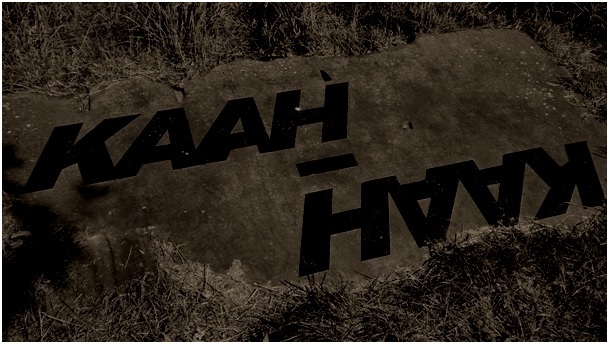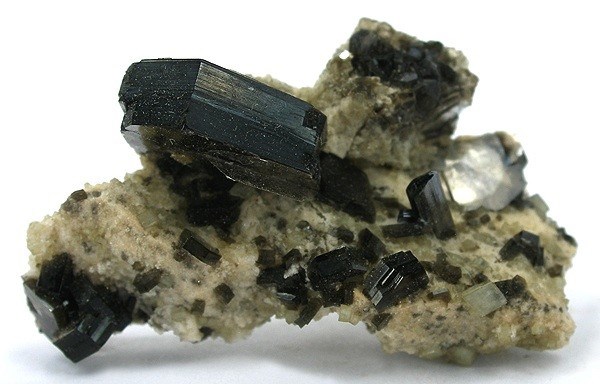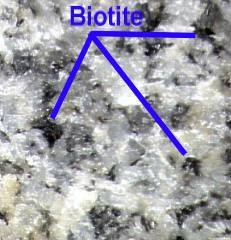
The key earth science learning point from this earthcache is to get to know key characteristics of granite, a typical bedrock. And one of its minerals, Biotite.
Granite is a common type of felsic intrusive igneous rock that is granular and phaneritic (visible crystals) in texture. Granites can be predominantly white, pink, or gray in color, depending on their mineralogy. Strictly speaking, granite is an igneous rock with between 20% and 60% quartz (the white mineral) by volume, and at least 35% of the total feldspar (white-pinkish) consisting of alkali feldspar, although commonly the term "granite" is used to refer to a wider range of coarse grained igneous rocks containing quartz and feldspar.
The term "granitic" means granite-like and is applied to granite and a group of intrusive igneous rocks with similar textures and slight variations in composition and origin. These rocks mainly consist of feldspar (white pinkish), quartz (white), mica (dark), and amphibole (dark) minerals, which form an interlocking, somewhat equigranular matrix of feldspar and quartz with scattered darker biotite mica and amphibole (often hornblende) peppering the lighter color minerals.
The action of crystal growth yields a crystalline solid whose atoms or molecules are typically close packed, with fixed positions in space relative to each other. The crystallization process consists of two major events, nucleation and crystal growth. Nucleation is the step where the solute molecules dispersed in the solvent start to gather into clusters, that become stable under the current operating conditions (pressure, temperature, supersaturation etc). Note that "crystal structure" is a special term that refers to the relative arrangement of the atoms, not the macroscopic properties of the crystal (size and shape), although those are a result of the internal crystal structure. Crystal growth spreads outwards from the nucleating site. In this faster process, the elements which form the motif add to the growing crystal in a prearranged system, the crystal lattice, started in crystal nucleation. The crystallization process is governed by the ambient temperature, the degree of supersaturation (amount of material available) and the pressure. If the temperature is kept stable, there is ample time for crystallization growth and ample supply of the molecules, the crystals will become larger then otherwise.
But lets focus on the mineral Biotite.

Biotite is a name used for a large group of black mica minerals that are commonly found in igneous and metamorphic rocks. These include annite, phlogopite, siderophyllite, fluorophlogopite, fluorannite, eastonite, and many others. These micas vary in chemical composition but are all sheet silicate minerals with very similar physical properties.
A generalized chemical composition for the biotite group is:
K(Mg,Fe)2-3Al1-2Si2-3O10(OH,F)2
The name "biotite" is used in the field and in entry-level geology courses because these minerals generally cannot be distinguished without optical, chemical, or x-ray analysis.
Biotite is a primary mineral found in a wide range of crystalline igneous rocks such as granite, diorite, gabbro, peridotite and pegmatite. It also forms under metamorphic conditions when argillaceous rocks are exposed to heat and pressure to form schist and gneiss. Although biotite is not very resistant to weathering and transforms into clay minerals, it is sometimes found in sediments and sandstones.

Properties of Biotite
Biotite is very easy to identify, and with a little experience a person will be able to recognize it on sight. It is a black mica with perfect cleavage and a vitreous luster on the cleavage faces. When biotite is separated into thin sheets, the sheets are flexible but will break upon severe bending. When held up to the light, the sheets are transparent to translucent with a brown, gray, or greenish color. Experienced observers can sometimes recognize phlogopite by its brown color.

You will normally find the biotite like this in a stone, and not in a big sized mineral as the photos above, so here is what you will be looking for at the stone at gz. (Example photo under, not from gz)

To log this cache.
To get to log this cache you will have to visit and answer the questions which are related to the coordinates given the earthcache.
When answers are collected, send them to CO for verification.
You can log immediately after answers are sent CO. If there are any questions about your answers CO will contact you.
Logs without answers to CO or with pending questions from CO will be deleted without any further notice.
Please do not include pictures in your log that may answer the questions.
Questions
1. Answer the questions under by visiting the Coordinates.
...
A. A1) Observe the stone, and descibe the crystals that you see!
A2) From what you have observed, do you think this granite slab has been formed deep or shallow into the earth’s crust?
...
B. How can you easily identify the Biotite?
...
C. The coordinates lead you to the KAAH KAAH. Have a good look at it - what percentage of the rock, do you think, is made up of biotite?
...
D. What shape and average size are the black 'spots' that you find within the rock?
...
2. (It’s voluntary to post a photo in your online log of your visit)
Without revealing any answers!
